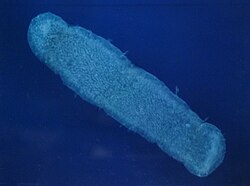| Pyrosoma | |
|---|---|
 | |
| Pyrosoma atlanticum | |
| Scientific classification | |
| Kingdom: | Animalia |
| Phylum: | Chordata |
| Subphylum: | Tunicata |
| Class: | Thaliacea |
| Order: | Pyrosomatida |
| Family: | Pyrosomatidae |
| Subfamily: | Pyrosomatinae |
| Genus: | Pyrosoma Péron, 1804 [1] |
| Synonyms [1] | |
| |
Pyrosoma is a genus of pyrosomes, marine colonial tunicates in the class Thaliacea. [1] [2] It contains four pelagic species found in temperate waters worldwide. Pyrosomes are filter feeders that uniquely use a type of continuous jet propulsion, generated by individual zooids, to slowly move forward while grazing; the species P. atlanticum has the highest known food clearance rate among zooplankton grazers. Colonies can reach lengths of up to 20 m (66 ft). [3] *Pyrosoma atlanticum* has special light organs that contain glowing bacteria (*Photobacterium* sp.), and these bacteria make the colony glow blue-green in the ocean. [4]






